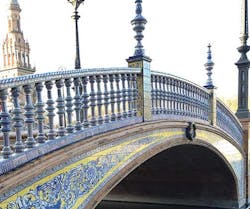Throughout the ages, humans have been haunted by the vastness of their history. They reconcile heritage and identity. They don’t want their actions to drift and settle like dust, so they forge something greater out of their work, their land, and themselves.
“People don’t buy what you sell them,” said Matias Martinez, quality manager of tile manufacturer Peronda. “They buy what you are.”
On a recent trip to Spain, I learned that Spaniards are a proud and noble people, and the aspect of their culture in which they take perhaps the most pride (aside from tapas and vino!) is tile production.
Ceramics are a vital aspect of Spain’s history and architecture. The work evokes passion and past, because tile is as much a part of the Spanish identity as any ancient anecdote. Spanish manufacturers
aim to make trends timeless. In the cities of Seville and Valencia, evidence of this is seen at any street corner, on any restaurant wall or hotel floor, and in any museum, cathedral, or courtyard.
The industry stretches from the studios of artisanal designers to the showrooms of commercial suppliers, and its foundations are as rich as the clay from which ceramics come forth. Dig through the following pages to unearth some of the undying styles seen at Cevisama, where I was hosted by Tile of Spain. It was a deep and delightful journey—truly once-in-a-lifetime, inspiring, eye-opening, and humbling. ¡Salud!
aparici
Based in L’Alcora, Spain, this manufacturer specializes in ceramic and porcelain tiles for floors and walls. Its booth offered something for everyone: scenes regal and rustic, clean and contemporary, and fun and funky like the Pop Culture collection that made the walls look like pages from a comic book.
At Cevisama, Aparici unveiled three offerings: Build was inspired by industrial concrete and appeals to designers with a taste for minimalistic design and durable quality; Retro resembles handmade encaustic tiles and brings a traditional aesthetic to modern environments; and Beyond mimics impressive stone slabs while providing technical performance characteristics.
Seen here are its Vanguard, Moving, and G-Stone lines, appearing
clockwise from top in Frankfurt's Soul Kitchen restaurant, Spain's Ryans Ibiza apartment, and Manchester's Malmaison Hotel.
natucer
Whereas many companies in the ceramic industry are concerned with productivity and standardization, Natucer has pursued a philosophy of exclusivity and experimentation, evidenced by the interesting shapes its tiles take: diamonds, hexagons, and even curved forms.
Its offerings are catered to a world that is becoming increasingly industrial and organizational, but still pines for the nostalgic and comfortable. The Boston Brick line captures the essence of a quarry in an artisanal style, while the 3D Hex collection combines striking colors with staggering contours.
The former could work in a classic setting, like the Timber line seen here in this Santiago de Compostela restaurant—while the latter might be better suited for a more carefree atmosphere, like a spa or salon.
peronda
At Cevisama, Peronda introduced the world to “Project Culture,” an initiative to include environmental stewardship in its manufacturing processes. The company collaborated with the Joan Rojeski design studio to recycle waste paper from its offices, which Joan Rojeski used to make new paper—the patterns and textures of which have been transposed onto the Craft line of tiles. For every square meter of the collection sold, Peronda will plant a tree in conjunction with the World Wildlife Fund.
Many of the supplier’s offerings are designed to emulate materials like wood and marble (like Foresta and Hettangia, seen below) while maintaining the performance and maintenance benefits of ceramic and porcelain. Peronda’s 360+ concept ensures that many of its offerings are available for any application, because the company utilizes a unique finish depending on whether the product is used indoors, outdoors, or on the wall.
tau
In recent years, Tau has observed the use of cement and concrete in bars, cafes, retail spaces, and any area seeking to provide a calm and modern atmosphere. It reproduces that look in ceramic tiles, enlivening the aesthetic with matte, gloss, and semi-polished finishes. The booth also depicted tiles with patterned prints as well as stone and wood mimics with interesting textures.
Since 2000 when the company earned a Certificate of Environmental Management, a recognition that it follows the specifications of international standard ISO 14001, Tau has continuously improved its manufacturing process through prevention, self-control, and ongoing training of employees. The manufacturer hopes to lead the industry in better utilization of resources.
togama
Offering a refreshing reprieve from the stack of ceramics at Cevisama, Togama introduced a textured glass mosaic collection called GEA (an acronym for glass, earth, and art—because the series is spawned where art and raw materials converge).
A closer look at its patterns reveals that GEA was inspired by planetary geology—its forms, textures, and overall brilliance have encapsulated the metal warps of Mercury, the volcanic craters of Venus, and the rocky deserts of Mars. Two color ranges are available: earth tones in MARS, FOREST, and DEIMOS; and cool blue and grey shades of CEO, BEAT, and TERRA.
Successful applications include hotel pools as well as spas and salons.
vives
Think of Vives’ Atlas collection as a map in which various fragments come together as one. It was inspired by different cultures and locations around the globe, captured in World Woods, World Streets, World Parks, and World Flysch. Many are offered in basic or anti-slip finishes, so they can be specified for several different environments.
The Streets line encompasses cosmopolitan and urban vibes, while the Wood can be cool and clean or burnt and blemished. Parks and Flysch each employ several strong and robust, yet elegant and delicate designs. Any line may be as likely as the other to appear at a stylish bistro, relaxing coffeehouse, or beachside lounge.
